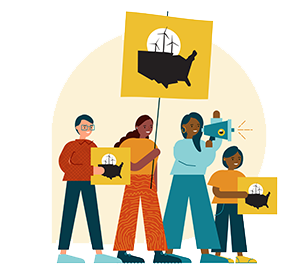Communications 101

- Communications 101
-
Section 3
Best Practices & Resources
-
Section 4
Tools, Tactics & Templates
-
Contact Us
Get help, give feedback, or share resources
What's Your Story?
Every cause, issue, and campaign that you’ll ever hear of begins with a story.
Stories capture our hearts and imaginations. They animate the policies and technical details in our advocacy, making it personal and emotional. Storytelling, says researcher Marshall Ganz, is what separates social movements from interest groups.
Emotional Drivers for Good Storytelling
Identify emotional triggers that move people to action.
What is Public Narrative? Self, Us, & Now
Public narrative worksheet that helps identify how you can use your story to call others to action.
Because stories speak the language of emotion, the language of the heart, they teach us not only how we ‘ought to’ act, but can inspire us with the ‘courage to’ act.
--Marshall Ganz
Stories are not incidental to the work we do — they are the very reason we’re changing public opinion and building a grassroots movement for 100% clean, renewable energy. We tell our stories strategically to generate support for our issues, motivate decision makers, encourage our communities to take action, neutralize opposition, and demand that the clean energy transition leaves no one behind. Megawatts and policy briefs alone are not going to win victories, but your story will.
Stories
Read about Sierra Club’s Work in Cleveland
This PRI story discusses Sierra Club’s work in Cleveland linking jobs, health, and climate change.
Sometimes activists assume that because something is true, it will be meaningful to the people we’re trying to reach. Unfortunately, it doesn’t work that way. Though our side has the facts and figures to refute our opponents, the fossil fuel industry and its allies have become experts at telling their own stories: “coal power is affordable,” “fossil fuels are plentiful,” “X utility company has a strong history of fair customer service,” and so on. To activate our allies, isolate our opponents, and win the hearts and minds of our community, we need to tell meaningful stories that go beyond facts.
Watch how Rev. Burton in St. Louis, Missouri shares his family and community’s stories about air quality and asthma to call for 100% clean energy.
“Communications” is the work of telling our stories, and the stories of our communities — whether that’s in meetings, events, media interviews, one-on-one conversations, emails, or on social media. Being a strategic communicator will help you use stories as a means to achieve campaign wins.
Strategic Storytelling
Solar farms and home weatherization programs won’t speak for themselves — that takes you.
Stories can only change hearts and minds when they are heard. City by city and town by town, the clean energy for all movement is gaining visibility and shifting the conversation about what’s possible — but this doesn’t happen by accident. We are consciously amplifying a public message to advance an equitable and just clean energy transition.
But, how do we get people to hear us? As you lead a 100% clean energy campaign in your community, who do you need to inform about your issues and bring along? What would you want them to do? What do you want them to think? Why is it important in the first place?
These questions can seem overwhelming when you’re trying to craft a single message or story, which is why it’s important to have a strategic communications plan so you can not only respond to events, but also tell your story proactively.
Your communications strategy should be tailored to the targets and audiences in your community, and centered around the issues that matter most to your neighbors and friends — whether that’s affordable energy bills, shutting down a fossil fuel facility, breathing clean air, stepping up on climate action, or investing in a local clean energy workforce. Creating a communications strategy is essential to build visibility and power around our movement in various venues, including traditional and social media.
Luckily, we have lots of tools, tactics, and templates to help you build your communications strategy. Let’s get started.
Try to answer these questions before moving on.
Your campaign story comes first — ultimately, it is the basis for your comms strategy. Narrowing in on your public narrative is key to developing a strong communications playbook to achieve your campaign goals.
E) all of the above — and more! Read on to the next section to nail all the tools in your comms toolbox.
False. Stories do! Personal and emotional storytelling are the backbone of social movements.